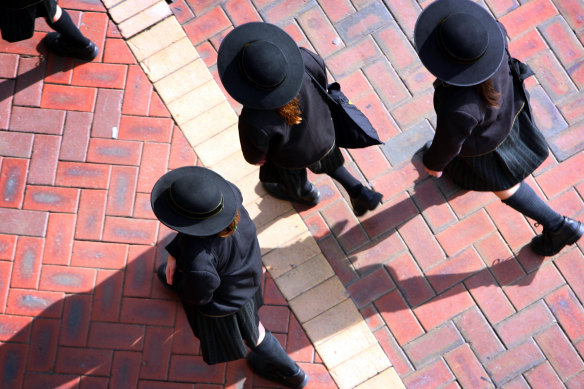This was published 7 months ago
Opinion
Blaming private schools for the underfunding of state schools is nonsense
David Hastie
Associate professorThe idea that public schools are underfunded in Australia is persistently being depicted as a ghastly controversy, a zero-sum game: public versus private; give to one, you take from the other; four legs good, two legs bad. A headline in this masthead this week describes Australia as a “lone wolf” in spending more on private schools than the global average, based on a recent snapshot of school funding from the Organisation for Economic Co-operation and Development.
But Australia has far more private schools than most other countries in the OECD, so it is not surprising that Australia spends more money on them. According to the OECD’s figures, about 40 per cent of Australian enrolments are in non-government schools, while the OECD average is 18 per cent. The Australian Bureau of Statistics puts the number lower at 36 per cent, but that still places Australia around third highest in the world with comparable nations, the others being Belgium, the Netherlands and the United Kingdom.

About 40 per cent of Australian enrolments are in non-government schools.Credit: Louie Douvis
When I recently visited Belgium and the Netherlands researching international school policy, I certainly didn’t see a bunch of snarling lone wolves loping up and down the canals. The high private school presence in these mild-mannered countries is regarded as entirely uncontroversial. Nor are they renowned as nations of great inequity – quite the contrary. But the state covers the entire cost of private schools in Belgium and the Netherlands.
Indeed, of the 27 countries in the European Union, 16 have state-funded private schools, also regarded as uncontroversial. The state funds almost all costs of private schools in France, Spain, Sweden and Finland, according to a recent report by OIDEL, a Swiss-based non-government organisation focused on freedom of education.
I agree there is an underfunding problem in Australian state schools, according to the Gonski Student Resource Standard funding model (SRS): a fixed amount allocated per student, per year. But it is not caused – as is often depicted in the public conversation – by a big bucket of money being diverted away from public to private schools.
The failure for funding public schools lies, rather, with the irresponsible behaviour of states and territories. For more than a decade, Labor and Coalition state governments alike have failed to do what they signed up to in the Gonski reforms: to fully fund students to the SRS. According to our Constitution, almost all state school funding comes from the states, and almost all private school funding comes from the Commonwealth. Since the Gonski reforms 13 years ago, the Commonwealth has mostly kept up its side of the bargain. The states have not.
So, blaming the funding of Australian private schools for the underfunding of state schools is simply nonsense. Nor is it the language of those who actually govern. Federal Education Minister Jason Clare has recently declared triumphantly that the Northern Territory and Western Australia will have fully funded public schools by 2026. But this wasn’t because Clare gave them a great sack of cash diverted from private schools: indeed the Commonwealth is only increasing its share of WA funding from 20 per cent to 22.5 per cent by 2026.
Rather, it was mostly Clare skilfully finding ways for WA to meet its existing responsibilities through political negotiations, to sign a “statement of intent” to move from 95 per cent to 100 per cent of what it agreed to 15 years ago, including matching dollar-for-dollar any Commonwealth increases. Only a federal Labor government could have convinced those Labor states to do this, and Clare must be applauded for doing what he could for public schooling, considering that he actually has very limited constitutional powers to do anything. He is not blaming private schools – because he knows they are not to blame.
The idea that state schools represent good, and private schools represent bad, is, in comparison with many other nations, an immature narrative. The private/public school arrangement in Australia is not a divide. It is a settlement. And has ever been: Catholic schools and other non-government schools have existed side by side with state schools for 150 years in Australia. All social settlements over time experience proportional shifts, and constantly need monitoring and tweaking, to ensure our plural democracy actually remains plural: that all citizens have an equal chance at the best life possible.
But the 3 million Australian parents who send their children to private schools don’t believe they are bad, and it is both simplistic and offensive to classify them as somehow complicit in undermining the Australian way. They are part of a new Australian way.
Associate Professor David Hastie is deputy vice president, development, of Alphacrucis University College. He presented on international school sector policy at the European Education Research Association conference in Cyprus in August.